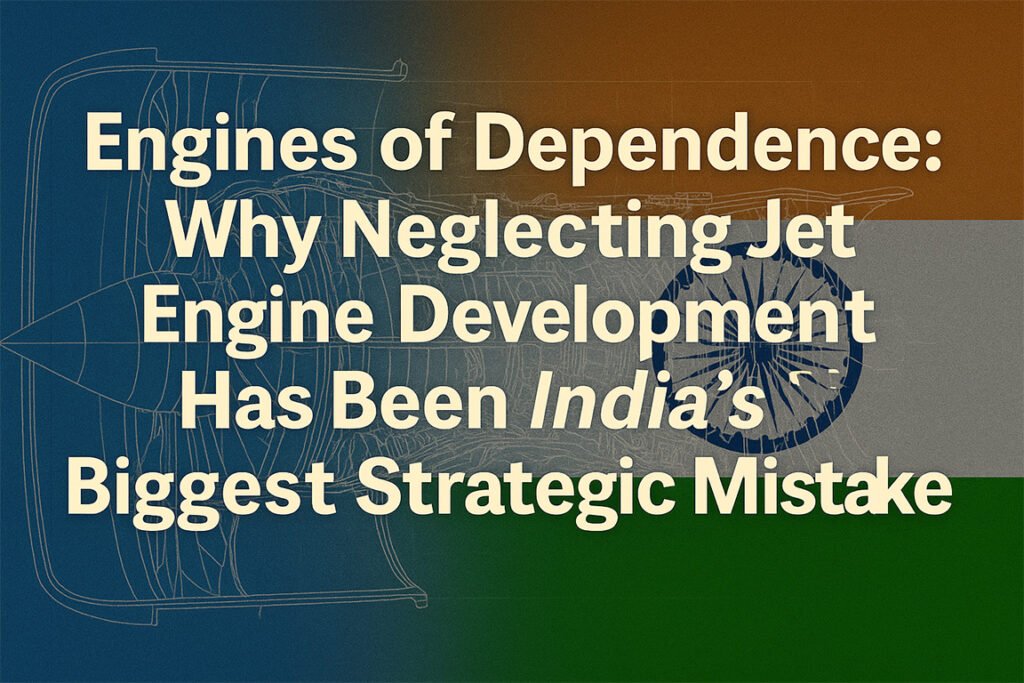
Engines of Dependence: Why Neglecting Jet Engine Development Has Been India’s Biggest Strategic Mistake
India’s military aviation sector has achieved major milestones from the HF-24 Marut in the 1960s to the indigenous Tejas fighter today. Yet, one critical technology has consistently eluded India the ability to design and manufacture indigenous fighter-class jet engines. This failure, rooted in decades of underinvestment, misplaced priorities, and dependence on licensed production, has left India reliant on foreign suppliers for its most critical airpower component.
- Executive Summary
China, starting later but investing consistently, now deploys the WS-10 and WS-15 engines in frontline fighters, while India fields imported GE F404s and AL-31FPs. Unless reversed through bold investment, international collaboration, and a focus on indigenous R&D, this vulnerability will remain India’s most significant handicap in 21st-century military modernisation.
- Background: Ambitions and Early Missteps
The HF-24 Marut (1950s–1970s) was India’s first indigenous fighter, designed by Kurt Tank, but it flew with the Rolls-Royce Orpheus 703 turbojet (21 kN thrust), which lacked afterburner capability. The planned uprated engines, Orpheus B.Or.12 or Egyptian E-300, never materialised as the Indian government was unwilling to pay the amounts the companies were asking for them. As a result, the Marut was underpowered and never achieved supersonic flight. This is a prime example of the irrational thinking of Indian governments and bureaucracy. The entire Marut program was turned into a white elephant, resulting in losses worth 10s of millions of dollars in 1960s currency rates and 100s of millions in today’s rates.
The GTRE Kaveri (1980s–2000s) was sanctioned in 1989 to power the Tejas. After three decades and ₹2,035 crore spent, it achieved only 76 kN thrust vs. 90 kN required. While 2,035cr or 500 million dollars might seem like a lot, its small amount for engine development.
Even Established companies like GE, Rolls-Royce, and Safran spent billions of dollars on each engine despite already possessing decades of experience and all necessary testing facilities. India’s Kavery program was crippled by lack of experience and facilities for metallurgy, turbine blade cooling, and test facilities, forcing Tejas to rely on imported GE F404s.
India’s reliance on license production (Tumansky R-11, R-25; AL-31FP; GE engines) never translated into true design know-how or know-why. Critical hot-section metallurgy and single-crystal blade technology were never transferred.
- Mistakes and Successes
India has imported or license-produced more than 2,000 fighter engines without fielding an indigenous equivalent. The Kaveri setback, coupled with a lack of test infrastructure, stalled progress. However, India achieved partial successes in niche areas — the Shakti helicopter engine (with Safran), small turbojets for cruise missiles, PTAE-7 and PTAE-7W engines for drones the ongoing co-production deal with GE for F414 engines (80% technology transfer).
- Lessons Learned
Jet engines require decades of sustained investment and advanced materials science; shortcuts don’t work. License production is not a true technology transfer. Strategic continuity matters: China persisted with WS-10 despite failures; India let GTRE falter.
- Strategic Risks of Continued Dependence
– Military vulnerability: Tejas Mk2 and AMCA depend on foreign engines; sanctions or denial could stall programs.
– Diplomatic leverage: Suppliers retain veto power over India’s fighter exports.
– Economic drain: $1B+ already committed to imported engines.
– Technological lag: Neglect of aero-engine R&D holds back India’s industrial ecosystem.
- Policy Recommendations
– Launch a National Aero Engine Mission with ₹20,000 crore funding over 15 years.
– Build full-spectrum test infrastructure
– high-altitude facilities, blade casting foundries, combustion labs.
– Pursue joint ventures with Safran or Rolls-Royce, demanding access to hot-section IP.
– Invest in human capital via IIT/DRDO-linked PhDs in propulsion and metallurgy.
– Develop dual-use engines for UAVs, transport aircraft, and regional jets to create scale.
Conclusion
India’s failure to invest in jet engine development is arguably the biggest strategic mistake in its military modernisation. From the Marut’s underpowered debut to the Kaveri’s failure, India lost six decades while China surged ahead. The price is a continued dependence on foreign cores for its frontline fighters. Unless corrected through bold political will and investment, India will remain a military power flying on borrowed wings.